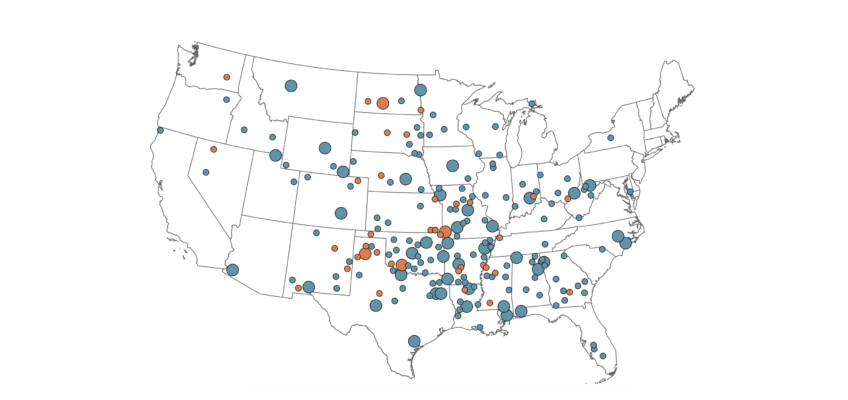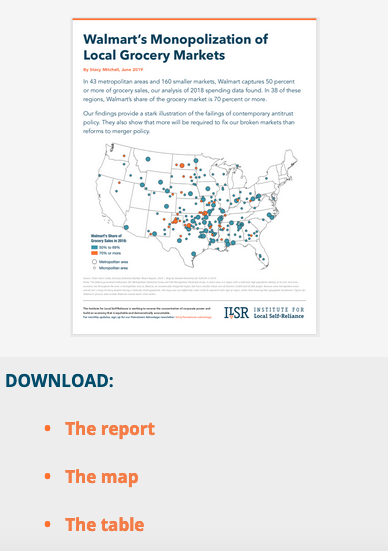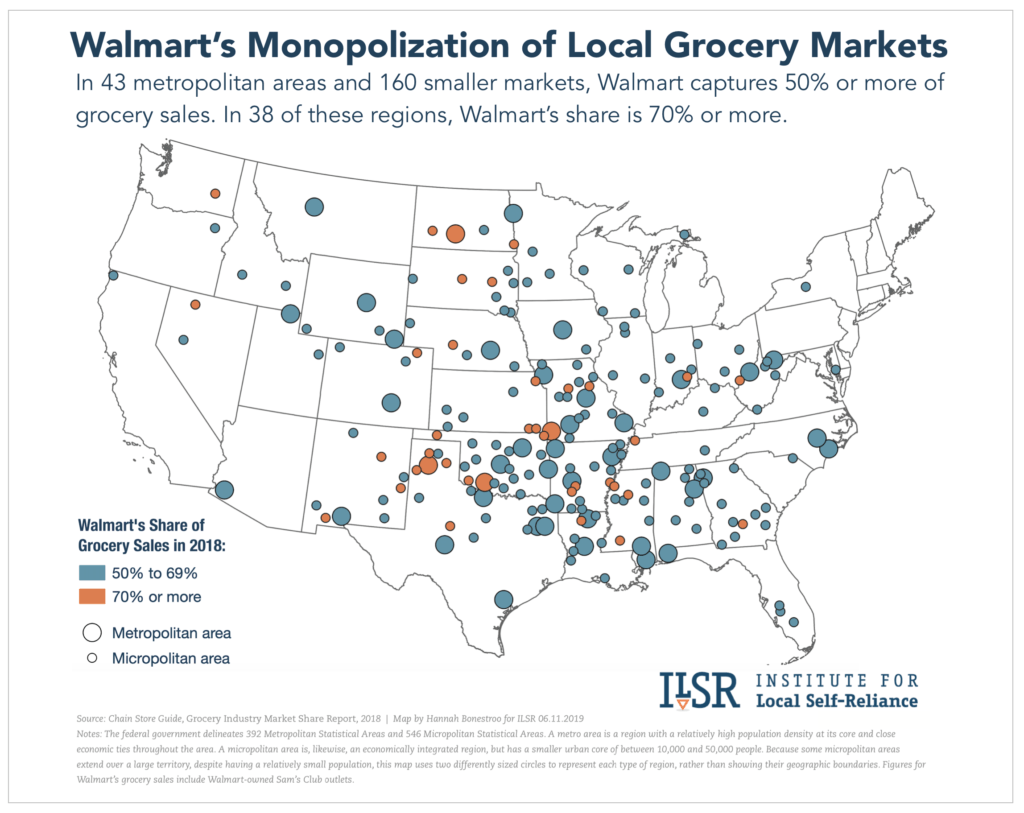ILSR: New Report: Walmart’s Monopolization of Local Grocery Markets
by Stacy Mitchell | 26 Jun 2019
In 43 metropolitan areas and 160 smaller markets, Walmart captures 50 percent or more of grocery sales, our analysis of 2018 spending data found. In 38 of these regions, Walmart’s share of the grocery market is 70 percent or more.
Our findings provide a stark illustration of the failings of contemporary antitrust policy. They also show that more will be required to fix our broken markets than reforms to merger policy.
By some measures, residents of Lawton, Okla., enjoy the kind of variety that befits a metropolitan region of 131,000 people. The community boasts more than 70 public parks. It’s home to three high schools and 18 elementary schools. Its neighborhoods are dotted with dozens of churches, two mosques, and, for non-believers, a secular society.
But when it comes to another facet of life — buying groceries — the options in Lawton are far more limited. Residents can shop at one of several Walmart stores. But beyond Walmart, the pickings are slim. Country Mart, a local chain, has two small grocery stores, each about a 15-minute drive from downtown Lawton, on opposite sides of the metro area. Aldi operates a small store in the city. Williams Discount Food has an outlet on the far northeastern edge of the metro, in the town of Elgin, a 20-minute drive from central Lawton. After that, there’s not much else for groceries. In many neighborhoods, if you don’t want to go to Walmart, the only other option is a dollar store. Dollar General and Family Dollar have about a dozen outlets in Lawton. These are poor substitutes for a supermarket, though: they carry only a very narrow selection of packaged items and no fresh produce.
Absent alternatives, most Lawton residents depend on Walmart. The chain started selling groceries in this part of Oklahoma 25 years ago. Today, it utterly dominates the region’s food supply. Last year, it captured 71 percent of the $238 million spent on groceries in the Lawton metropolitan area. (Country Mart picked up 10 percent, while the two dollar store chains together took in 9 percent. The area’s remaining food retailers accounted for the rest.)
While the level of concentration in Lawton’s grocery market is extreme, the region is hardly an outlier. In fact, it’s typical of a sizable number of U.S. communities, according to our analysis of industry data from the market research firm Chain Store Guide. We found that there are 203 places — including 43 metropolitan areas and 160 smaller “micropolitan” markets [1] — where Walmart captures 50 percent or more of grocery sales. That’s one in every ten metropolitan areas and nearly one in three micropolitan areas.
In 38 of these regions, including in such populous places as Amarillo, Texas, and Bismarck, N.D., Walmart’s share of the grocery market is now 70 percent or more. (A complete list can be found in the table at the end of this report.) Nationwide, Walmart captures $1 in $4 that Americans spend on groceries. That’s more than the market share of the next five largest supermarket chains combined. [2]
Our findings illustrate the failure of contemporary antitrust policy. For nearly four decades, the two agencies that enforce the antitrust laws, the U.S. Department of Justice and the Federal Trade Commission, have given corporations like Walmart a free hand to use their size and financial might to consolidate markets. This lax approach was supposed to generate widespread benefits for Americans. Instead, it has left a remarkable number of places without a competitive market for even the most basic of daily needs.
Even by the permissive standards of today’s Justice Department, Walmart’s market power is considered extreme. Under guidelines [3] established by the department’s Antitrust Division in 2010, markets in which one corporation captures more than 50 percent of revenue are defined as “highly concentrated.” (The agency has repeatedly raised this threshold since the 1960s, including sharply increasing it in 2010. [4] These guidelines are used to evaluate mergers.)
For communities, this lack of competition has consequences. It leaves them vulnerable to the dictates of a distant monopolist. In places like Atchison, Kan., and North Platte, Neb., Walmart’s near-total market control gives it extraordinary power to decide which foods and brands are available locally and thus to shape what people buy and eat. It can raise prices, or cut service, or suddenly pull a popular product from its shelves, with little risk of losing customers. In fact, Walmart has a history of charging higher prices in less competitive markets. [5]
At the same time, Walmart’s command of the grocery market nationally allows it to manipulate food producers, and to keep a bigger cut of consumer spending for itself. For every dollar Americans spend on groceries, farmers are now receiving less than 15 cents, the smallest portion since the U.S. Department of Agriculture began tracking this data in 1993. [6] Meanwhile, two sets of corporations along an increasingly consolidated supply chain are taking a larger piece of the pie: big food processors and giant supermarket chains, chiefly Walmart.
It’s not only farmers who are being squeezed. People who pack vegetables, process milk, and slaughter beef are being paid less because of Walmart’s ability to pressure suppliers, new research suggests. Harvard University sociologist Nathan Wilmers has found evidence that, among production companies, greater dependence on a small number of powerful corporate buyers leads to lower wages. [7]
Many of the communities hardest hit by falling incomes for farmers and food workers are in the Midwest. This region is also home to many of Walmart’s most concentrated local grocery markets. In other words, some of the people most harmed by Walmart’s market power may have little choice but to shop there.
How Policymakers Allowed Walmart to Monopolize Grocery Markets
No other corporation in history has ever amassed this degree of control over the U.S. food system. The closest comparison, the A&P supermarket chain, accounted for 16 percent of U.S. grocery sales at its peak in 1933, [8] a considerably smaller share than Walmart, which today controls about one-quarter of the national market.
Yet A&P provoked a very different response from policymakers than Walmart has. Concerned that the company was using its size to pressure suppliers for discounts not available to other grocers, Congress in 1936 added a new law to the government’s antitrust arsenal. Aimed squarely at checking the power of big retailers, the Robinson-Patman Act barred chains from using their leverage as major buyers of goods to coerce suppliers into charging them less and their competitors more. After the law’s passage, A&P’s market share began to fall. Nevertheless, in 1944, the Justice Department concluded that A&P still had too much market power. It filed an antitrust suit against the chain, which ultimately led A&P to spin off part of its operations.
By the time Walmart began to expand across the country, though, the policy environment had shifted dramatically. In the 1980s, the federal antitrust agencies radically changed how they interpret and enforce the antitrust laws. Convinced that big companies were more efficient and therefore better for consumers, the Justice Department and Federal Trade Commission decided to give large corporations more leeway to use their size and financial might to crush smaller competitors and seize market power.
Two changes in policy proved particularly advantageous to Walmart. First, the antitrust agencies stopped enforcing the Robinson-Patman Act, effectively repealing the law without involving Congress. This gave Walmart a free hand to bully suppliers — and to flex exactly the kind of muscle that an earlier generation of policymakers had denied to A&P. Walmart became notorious for its aggressive dealings with food companies. Over time, the impact snowballed: Walmart wrested steep discounts from suppliers, which it used to fund its expansion, thereby gaining more market share, which it then leveraged to extract even bigger discounts. All the while, smaller grocers faced rising costs as suppliers scrambled to make up the revenue. [9]
The second shift that aided Walmart’s monopoly ambitions came in 1993 when the U.S. Supreme Court made it virtually impossible to prosecute predatory pricing. [10] Predatory pricing occurs when a company sells goods below cost in order to take market share from rivals that can’t afford to sustain similar losses. Skeptical that low prices could ever be harmful, the Court set the bar for proving predatory pricing so high as to effectively legalize it.
Selling at a loss had long been a staple of Walmart’s growth strategy and, in the early 1990s, it drew legal action. Three local pharmacies in Conway, Ark., filed suit alleging that Walmart was selling below cost to drive them out of business. Evidence presented in the case showed that Walmart was in fact selling items like shampoo and toothpaste at a loss. The record also showed that Walmart charged higher prices for these items elsewhere, suggesting that its ultra-low prices might last only as long as the local competition remained open. A lower court sided with the pharmacists, but by the time the case reached Arkansas’s top court, the U.S. Supreme Court had issued its pivotal decision on predatory pricing. In a split 4-3 decision, the Arkansas Supreme Court, which was weighing questions of state, as well as federal, antitrust law, endorsed the higher court’s logic and ruled that Walmart’s tactics did not harm competition.
Five years before the ruling, in 1988, Walmart had opened its first supercenter, in the small town of Washington, Mo. The massive store combined Walmart’s typical array of merchandise with a full supermarket, and it marked the retailer’s first step into groceries. Now free to exercise its clout in ways that would have once prompted antitrust scrutiny, Walmart had little standing in its way. Less than a decade later, in 2001, it had become the largest grocer in the country.
What’s Needed to Fix Our Broken Grocery Markets
With concern about market concentration on the rise, several members of Congress have introduced bills to bolster antitrust enforcement. So far, though, their proposed reforms mainly focus on strengthening the merger review process to block future corporate tie-ups. While merger reform is essential, on its own, it’s insufficient, as our case study of Walmart shows. Walmart did not grow to monopolize dozens of local grocery markets through acquisitions. And blocking future retail mergers will do little to restore competition in places like Lawton.
Nor should we imagine that Amazon’s expansion into groceries will be the solution. In fact it’s more of the same problem, but with troubling new dimensions. Like Walmart, Amazon is a powerful buyer that can squeeze food producers, and it’s a conglomerate that can use profits from other divisions to absorb losses as it moves into groceries. Its ability to exploit data and its position as a gatekeeper for online commerce only add to its muscle. Rather than increasing competition, Amazon’s entry into groceries is likely to lead to even more consolidated markets.
To restore competition and diversity in our local grocery markets, policymakers will need to do three things:
- Enforce the Antitrust Laws: First, we need to enforce the antitrust laws in accordance with their purpose, which was not to chase the idea of maximum efficiency, but rather to structure markets to promote competition. This means aggressively enforcing restrictions on predatory pricing and buyer power, two means by which corporations like Walmart and Amazon can use their sheer size to hobble rivals and eliminate competition.
- Require Walmart to Sell Off Stores: Second, the Federal Trade Commission should review the 203 markets in which Walmart controls 50 percent or more of grocery sales and, in as many as is feasible, compel the retailer to divest stores. In fact, the agency has already articulated the case for this. When the Albertson’s and Safeway chains sought to merge in 2015, for example, the FTC insisted that the companies sell off grocery stores in 130 markets. In its complaint, the FTC noted that these markets would otherwise be too concentrated, with the number of “meaningful competitors” in each market falling to four or fewer. These same concerns should motivate the FTC to intervene in local grocery markets in which Walmart’s dominance has minimized or eliminated meaningful competition. Divestitures are not limited to merger cases. They can also be used to break up concentrated markets, as the government did in 1984 when it forced AT&T to divest parts of its telephone service.
- Expand the Availability of Capital for Independent Grocers: One important way to diversify our food sector is to enable local entrepreneurs to start grocery businesses. Local grocery stores provide distinct consumer and community benefits that large chains can’t match. [11] But it’s become harder to secure a loan to start a grocery store, in large part because of the decline of community banks. [12] This lack of capital isn’t just impeding startups. It’s also threatening the nation’s 20,000 existing local grocery stores, whose future depends on a new generation of owners having the financing to buy and operate them. To support grocery market competition, policymakers should take steps to reverse banking consolidation and establish grocery-focused lending programs, such as the Pennsylvania Fresh Food Financing Initiative. [13]
***
After the government intervened to check A&P’s market power in the 1930s and 1940s, the grocery chain continued to be a strong competitor for many decades. But it no longer had a free hand to extract special terms from suppliers at the expense of rival grocers, or to roll up food production under its own labels. A&P’s market share ebbed. The years that followed saw a flush of grocery startups, which helped fuel competition and broaden prosperity.
Dismantling Walmart’s market power would have a similar effect today. Walmart would continue to be a buyer and seller of groceries. But it would no longer be an overbearing force, straddling entire regions and single-handedly regulating much of the nation’s food production. Pruning Walmart’s dominance would open up space for new grocers. It would create more competition for farmers and food producers. And it would deliver dozens of communities from the monotony and risk of relying on a single absentee corporation for their daily bread.
Photo credit: Mike Mozart
[1] Micropolitan areas, as defined by the U.S. Office of Management and Budget, are integrated labor market regions surrounding an urban center with a population of between 10,000 and 50,000 people. Metropolitan areas are economically integrated regions as well, but with a larger urban center.
[2] “Online and offline grocery market share of leading food retailers in the United States in 2017,” Statista Research Department, May 13, 2019.
[3] “Market Concentration,” Section 5.3 of “Horizontal Merger Guidelines,” United States Department of Justice and Federal Trade Commission, Aug. 19, 2010. c
[4] “Wave of Megadeals Tests Antitrust Limits in U.S.,” Theo Francis and Ryan Knutson, Wall Street Journal, Oct. 18, 2015.
[5] See, for example, evidence presented in Wal-Mart Stores, Inc. v. American Drugs, Inc. 891 S.W.2d 30 (1995).
[6] “Food Dollar Series,” United States Department of Agriculture Economic Research Service, Mar. 14, 2019.
[7] “Wage Stagnation and Buyer Power: How Buyer-Supplier Relations Affect U.S. Workers’ Wages, 1978 to 2014,” Nathan Wilmers, American Sociological Review, Mar. 27, 2018.
[8] “Economic Report on the Structure and Competitive Behavior of Food Retailing: A Staff Report,” Federal Trade Commission, Jan. 1966.
[9] “Wal-Mart Ratchets Up Pressure on Suppliers to Cut Prices,” Paul Ziobro and Serena Ng, Wall Street Journal, Mar. 31, 2015; “Big Food Faces Pressure From Retailers Demanding Discounts,” Annie Gasparro, Sarah Nassauer and Heather Haddon, Wall Street Journal, Aug. 31, 2017.
[10] Brooke Group Ltd. v. Brown & Williamson Tobacco Corp., 509 U.S. 209 (1993).
[11] “The View from the Shop—Antitrust and the Decline of America’s Independent Businesses,” Stacy Mitchell, Antitrust Bulletin, June 2017.
[12] “Understanding the Small Business Credit Crunch,” Institute for Local Self-Reliance, Apr. 16, 2014.
[13] “Pennsylvania Seeds a New Crop of Local Grocery Stores,” Stacy Mitchell, Institute for Local Self-Reliance, Sept. 12, 2008.
Lead Photo: Eric Staszczak







